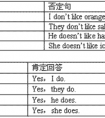改错。( ) 1.Theywantedtomakingsomenewclothes. _______________ABC( ) 2.OurschoolwillhaveaconcertinChildren'sDay._______________ABC( ) 3.Englishismostdiffic-五年级英语
|
人称 |
单数 |
复数 | ||
|
主格 |
宾格 |
主格 |
宾格 | |
|
第一人称 |
I |
me |
we |
us |
|
第二人称 |
you |
you |
you |
you |
|
第三人称 |
he |
him |
they |
them |
|
she |
her | |||
|
it |
it | |||
人称代词分主/宾,只有八对要区分。
你(们)、它主/宾同一形,其余主/宾须分清。
谓语之前主格填,动/介之后宾格跟,
口语运用最灵活,表语也可用宾格。
人称代词并列现,注意顺序礼貌见,
二一、三一、二三一,第一人称最谦虚,
若把错误责任担,第一人称须当先。
考点名称:不规则形容词的比较级
- 不规则形容词的比较级:
有几个特殊的单词,它的比较级是不规则的,如(good-better, bad-worse, many / much-more)用于两个人或事物的比较,
结构为:形容词比较级+than意为:“比……更……”。
例:This book is better than that one. 这本书比那本好。
下表举例列举一些不规则形容词的原级和比较级。
原级 比较级 beautiful more beautiful good/well better bad worse many/much more little/few less 形容词比较级使用注意事项:
1、比较的两者应该是互相对应的可比较的东西。
典型错误:My hair is longer than you.(我的头发比你更长。)
比较的两者是我的头发、你(整个人),那么比较的对象就没有可比性。
应该改为:My hair is longer than yours. 或My hair is longer than your hair.
附:如果比较的两者是一样的时候,我们会用 as…as…这个词组,它的用法是:
什么+be+as+形容词原形+as+什么,意思是什么和什么一样……。如:
I’m as tall as you.(我和你一样高。)
My feet are as big as yours.(我的脚和你的一样大。)2、
①有些形容词词是没有比较级的,如:
Chinese, Japanese等表示国际的形容词;
还有right, wrong, dead, empty 等含有较为绝对的词等。
②much, even, still, a little, a bit 等修饰词
在比较级前常用 much (….得多) , even (甚至), still (更), a little (一点),a bit (有点)等来修饰形容词,表示“程度进一步加深”。如:
Kay is a little taller than Mary. 凯比玛丽高一点儿。
3、句中有very, so, too, quite, rather 等程度副词时,一般只能用形容词的原级,不能用比较级形式。- 形容词比较级的核心句型:
(1)Which/Who… ,A or B ?
Or与选择疑问句相连,且有两者提供选择,前面的形容词要用比较级形式。如:
Which do you like better, water or orange ? 水和桔子汁,你更喜欢哪一种?
(2)get/ become …and…
Get/ become 后面接“比较级+and+比较级” ,这是表示“变得越来越。。。”
若比较级是“原级+er”构成的,则用“ 比较级+and+比较级”的形式。
若比较级是多音节词,就用“more and more +原级”结构。
(3)the +比较级+of the two… 表示“两者中较。。。的” 如:
Vince is the taller of the two. 文斯是两个中较高的一个。
(4) the +比较级,the+比较级… 此句型表示“越。。。,越。。。” 如:
The higher you stand, the farther you will see. 你站得越高,就看得越远。
考点名称:介词
- 介词:
是用来表示它后面的名词(代词)或起名词作用的短语、从句与句中其他成分之间的关系。
介词是英语中很活跃的词,一般置于名词之前。它常和名词或名词性词语构成介词短语。
同一个介词常和不同的词语搭配形成固定搭配,表示不同意义。 介词分类:
一、表示地点位置的介词
(1)at, in, on, to, for
at 表示在小地方;表示“在……附近,旁边”。
in 表示在大地方;表示“在……范围之内”。
on 表示毗邻,接壤,“在……上面”。
to 表示在……范围外,不强调是否接壤;或“到……”。
(2)above, over, on 在……上
above 指在……上方,不强调是否垂直,与below相对;
over 指垂直的上方,与under相对,但over与物体有一定的空间,不直接接触。
on 表示某物体上面并与之接触。
例:The bird is flying above my head. 小鸟在我的头上飞。
There is a bridge over the river. 在河上有一座桥。
He put his watch on the desk.他把他的表放在了桌子上。
(3)below, under在……下面
under 表示在……正下方
below 表示在……下,不一定在正下方
例:There is a cat under the table. 桌子底下有一只猫。
Please write your name below the line. 请在横线下写上你的名字。
(4)beside,behind beside 表示在……旁边
behind 表示在……后面
二、表示时间的介词
(1)in,on,at在……时
A、in表示较长时间,如世纪、朝代、时代、年、季节、月及一般(非特指)的早、中、晚等。
如:inthe1950s, in1989, insummer, inJanuary, inthemorning等。
B、on 表示具体某一天及其早、中、晚。
如:on May 1st, on Monday, onNew Year’s Day, on a cold night in January, on a fine morning, on Sunday afternoon等。
C、at 表示某一时刻或较短暂的时间,或泛指圣诞节,复活节等。
如:at 3:20, at this time of year, at the beginning of, at the end of, at the age of, at Christmas, at night, at noon, at this moment等。
(2)after在……之后 “after+一段时间”表示过去的一段时间以后;
- 最新内容
- 相关内容
- 网友推荐
- 图文推荐
| [家长教育] 孩子为什么会和父母感情疏离? (2019-07-14) |
| [教师分享] 给远方姐姐的一封信 (2018-11-07) |
| [教师分享] 伸缩门 (2018-11-07) |
| [教师分享] 回家乡 (2018-11-07) |
| [教师分享] 是风味也是人间 (2018-11-07) |
| [教师分享] 一句格言的启示 (2018-11-07) |
| [教师分享] 无规矩不成方圆 (2018-11-07) |
| [教师分享] 第十届全国教育名家论坛有感(二) (2018-11-07) |
| [教师分享] 贪玩的小狗 (2018-11-07) |
| [教师分享] 未命名文章 (2018-11-07) |


![I want to ______________a science teacher one day![ ]A. beB. isC. are-六年级英语](http://www.00-edu.com/d/file/ks/4/1/58/2019-08-28/small0786c619dff6ea7cc013f1222e770e571566922364.png)
![Let's get ____ work![ ]A. on B. inC. to-四年级英语](http://www.00-edu.com/d/file/ks/4/1/58/2019-08-28/smallaeead033e0df4ab64ad92e4eecbe84ed1566922686.png)
![It's 10 o'clock. It's time_________go to school.[ ]A. toB. forC. of-四年级英语](http://www.00-edu.com/d/file/ks/4/1/58/2019-08-28/smallcbd5ebed803baef3505fe0cd5bc985461566922628.jpg)

